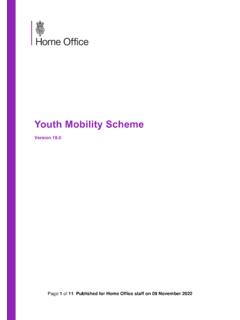Transcription of THE ICF: AN OVERVIEW - Centers for Disease Control and ...
1 THE ICF: AN OVERVIEW INTRODUCING THE ICF The International Classification of Functioning, Disability and Health (ICF) is a framework for describing and organising information on functioning and disability. It provides a standard language and a conceptual basis for the definition and measurement of health and disability. The ICF was approved for use by the World Health Assembly in 2001, after extensive testing across the world involving people with disabilities and people from a range of relevant disciplines. A companion classification for children and youth (ICF-CY) was published in 2007. The ICF integrates the major models of disability. It recognises the role of environmental factors in the creation of disability, as well as the relevance of associated health conditions and their effects. This OVERVIEW provides a brief introduction to the ICF its structure, contents, purposes and applications. Aims The ICF is a multipurpose classification system designed to serve various disciplines and sectors for example in education and transportation as well as in health and community services and across different countries and cultures.
2 The aims of the ICF (WHO 2001:5) are to: provide a scientific basis for understanding and studying health and health-related states, outcomes, determinants, and changes in health status and functioning; establish a common language for describing health and health-related states in order to improve communication between different users, such as health care workers, researchers, policy-makers and the public, including people with disabilities; permit comparison of data across countries, health care disciplines, services and time; and provide a systematic coding scheme for health information systems. The ICF has been accepted as one of the United Nations social classifications .. and .. provides an appropriate instrument for the implementation of stated international human rights mandates as well as national legislation (WHO 2001:5-6). Hence, the ICF provides a valuable framework for monitoring aspects of the UN Convention on the Rights of Persons with Disabilities (UN 2006), as well as for national and international policy formulation.
3 Underlying principles Four general principles guided the development of the ICF and are essential to its application. Universality. A classification of functioning and disability should be applicable to all people irrespective of health condition and in all physical, social and cultural contexts. The ICF achieves this and acknowledges that anyone can experience some disability. It concerns everyone s functioning and disability, and was not designed, nor should be used, to label persons with disabilities as a separate social group. Parity and aetiological neutrality. In classifying functioning and disability, there is not an explicit or implicit distinction between different health conditions, whether mental or 'physical'. In other words, disability is not differentiated by aetiology. By shifting the focus from health condition to functioning, it places all health conditions on an equal footing, allowing them to be compared using a common metric.
4 Further, it clarifies that we cannot infer participation in everyday life from diagnosis alone. Neutrality. Domain definitions are worded in neutral language, wherever possible, so that the classification can be used to record both the positive and negative aspects of functioning and disability. Environmental Influence. The ICF includes environmental factors in recognition of the important role of environment in people s functioning. These factors range from physical factors (such as climate, terrain or building design) to social factors (such as attitudes, institutions, and laws). Interaction with environmental factors is an essential aspect of the scientific understanding of 'functioning and disability'. THE ICF MODEL In the ICF, functioning and disability are multi-dimensional concepts, relating to: the body functions and structures of people, and impairments thereof (functioning at the level of the body); the activities of people (functioning at the level of the individual) and the activity limitations they experience; the participation or involvement of people in all areas of life, and the participation restrictions they experience (functioning of a person as a member of society); and the environmental factors which affect these experiences (and whether these factors are facilitators or barriers).
5 The ICF conceptualises a person's level of functioning as a dynamic interaction between her or his health conditions, environmental factors, and personal factors. It is a biopsychosocial model of disability, based on an integration of the social and medical models of disability. As illustrated in Figure 1, disability is multidimensional and interactive. All components of disability are important and any one may interact with another. Environmental factors must be taken into consideration as they affect everything and may need to be changed. 4 Health condition (disorder or Disease )ICF: Interaction of conceptsEnvironmental FactorsPersonal FactorsBody Functions andStructuresActivitiesParticipation4 Figure 1: Interactions between the components of ICF (WHO 2001:18) Although personal factors are recognised in the interactive model shown in Figure 1, they are not classified in the ICF at this time. Such factors influence how disability is experienced by the individual and some, such as age and gender, are commonly included in data collections.
6 The ICF can provide or underpin a descriptive profile of an individual's pattern of functioning, not a 'yes' or 'no' answer about whether he or she is disabled. A decision about where to draw a line between no disability and disability depends on the purposes for doing so. Individual measures, surveys and other applications must be based on this understanding as well as the knowledge that there are multiple dimensions of disability, and potentially multiple perspectives to consider. Different measurement or policy purposes may result in different decisions about which aspects of disability to focus on and which thresholds are relevant and hence in different measures and estimates at individual or population level. ICF components and their contents The major components of functioning and disability are set out and defined in Box 1; these are understood in the context of health which clarifies that participation restrictions related to other factors, for example racial prejudice, are not within the scope of the ICF.
7 Box 1: Definitions: Functioning, disability and the components of the ICF Body functions - The physiological functions of body systems (including psychological functions). Body structures - Anatomical parts of the body such as organs, limbs and their components. Impairments - Problems in body function and structure such as significant deviation or loss. Activity - The execution of a task or action by an individual. Participation - Involvement in a life situation. Activity limitations - Difficulties an individual may have in executing activities. Participation restrictions - Problems an individual may experience in involvement in life situations. Environmental factors - The physical, social and attitudinal environment in which people live and conduct their lives. These are either barriers to or facilitators of the person's functioning. Functioning is an umbrella term for body function, body structures, activities and participation. It denotes the positive or neutral aspects of the interaction between a person s health condition(s) and that individual s contextual factors (environmental and personal factors).
8 Disability is an umbrella term for impairments, activity limitations and participation restrictions. It denotes the negative aspects of the interaction between a person s health condition(s) and that individual s contextual factors (environmental and personal factors). Source: WHO 2001:8,10 Each component contains hierarchically arranged domains. These are sets of related physiological functions, anatomical structures, actions, tasks, areas of life, and external influences. The ICF has a separate chapter for each of the domains as listed in Table 1. Table 1: ICF components and domains/chapters Body Function: Mental functions Sensory functions and pain Voice and speech functions Functions of the cardiovascular, haematological, immunological and respiratory systems Functions of the digestive, metabolic, endocrine systems Genitourinary and reproductive functions Neuromusculoskeletal and movement-related functions Functions of the skin and related structures Activities and Participation: Learning and applying knowledge General tasks and demands Communication Mobility Self care Domestic life Interpersonal interactions and relationships Major life areas Community, social and civic life Body Structure.
9 Structure of the nervous system The eye, ear and related structures Structures involved in voice and speech Structure of the cardiovascular, immunological and respiratory Systems Structures related to the digestive, metabolic and endocrine systems Structure related to genitourinary and reproductive systems Structures related to movement Skin and related structures Environmental Factors: Products and technology Natural environment and human-made changes to environment Support and relationships Attitudes Services, systems and policies Source: WHO 2001: 29-30 Measurement The ICF is a framework and classification system on which tools for measuring or assessing individual functioning may be based, and to which they can be mapped. The broad framework puts assessment in context and provides the focus for selecting relevant aspects of functioning and disability for assessment. Qualifiers are codes used to record the extent of functioning or disability in a domain or category, or the extent to which an environmental factor is a facilitator or barrier.
10 A uniform or 'generic' qualifier scale is provided to record the extent of the 'problem' in relation to impairment, activity limitation and participation restriction as shown in Box 2. The environmental factors qualifier uses both a positive and negative scale, to indicate the extent to which an environmental factor acts as either a facilitator or barrier to functioning. Measurement is an area for further development and it is recognised that the generic qualifier requires calibration to relate its scale to existing measurement tools. Box 2: ICF Qualifier scales Generic qualifier: 0 No problem 1 Mild problem 2 Moderate problem 3 Severe problem 4 Complete problem 8 Not specified 9 Not applicable Qualifier for Environmental factors: .0 No barrier +0 No facilitator .1 Mild barrier +1 Mild facilitator .2 Moderate barrier +2 Moderate facilitator .3 Severe barrier +3 Substantial facilitator .4 Complete barrier +4 Complete facilitator.


















